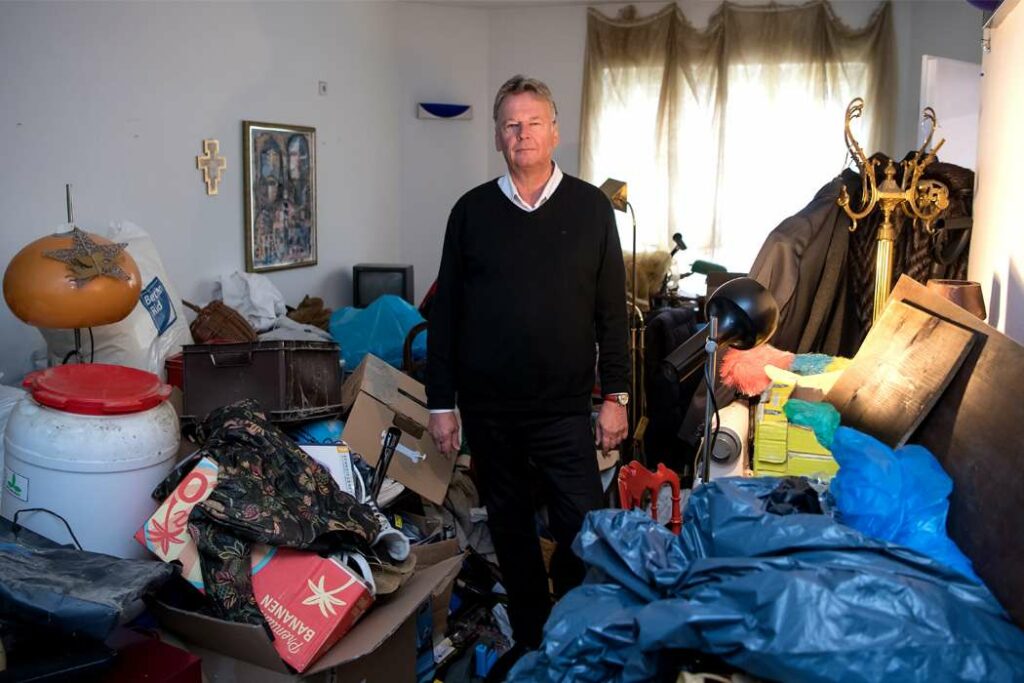Hoarding disorder is a mental health condition that affects approximately 2-5% of the population. People who suffer from it accumulate excessive amounts of items and have difficulty getting rid of them, even if they no longer need them or if they are causing harm to their lives. If you think you may be suffering from hoarding disorder, it’s important to get help. In this blog post, we will discuss the symptoms, causes, and treatment of hoarding disorder.
Contents
What Is Hoarding Disorder?
 Hoarding disorder is a mental disorder characterized by the persistent difficulty of discarding or parting with possessions, regardless of their actual value. People with this illness excessively save items. And often struggle to organize or categorize their collections.
Hoarding disorder is a mental disorder characterized by the persistent difficulty of discarding or parting with possessions, regardless of their actual value. People with this illness excessively save items. And often struggle to organize or categorize their collections.
Hoarding is not the same as collecting. Collectors are usually proud of their things and can enjoy displaying them to others. In contrast, people with hoarding disorder typically experience embarrassment about their possessions. The people may feel extreme anxiety at the thought of getting rid of them.
In fact, the disorder is somehow related to obsessive-compulsive disorder (OCD). Both conditions share similar symptoms. And both cause significant distress and impairment in functioning.
The disorder is very often associated with other mental health conditions. These include depression, anxiety disorders, attention-deficit/hyperactivity disorder (ADHD), and substance abuse disorders. It affects people of all ages and genders. But it’s more common in older adults. Estimates suggest that hoarding disorder affects between two to five percent of the population.
What Causes Hoarding Disorder?
The exact cause of hoarding disorder is unknown. But there are some of the possible causes that have been identified which include:
Genetic Factors
The disorder seems to run in families, which suggests that genetic factors may play a role. Also, the genetic link may explain why it is more common in people with other mental health conditions, such as anxiety or depression.
It is also possible that hoarding disorder is caused by a problem with the brain. For example, some people with hoarding disorder have difficulty processing information and making decisions. This may be due to problems with the frontal lobe of the brain, which is responsible for planning and organizing.
Environmental Factors
Hoarding may be more common in certain cultures or families where collecting items are valued. In addition, people who grew up in chaotic or cluttered homes may be more likely to hoard.
More often, environmental factors seem to play a role in the development of hoarding disorder. For example, people who have experienced a traumatic event, such as a natural disaster or the death of a loved one, maybe more likely to develop this. This is because they may see hoarding as a way to feel safe and in control.
Brain Changes
Studies have shown that people with hoarding disorder have different brain structures and functions compared to those without the condition. These differences may be associated with how a person processes information and makes decisions. Brain changes are often associated with other mental health conditions, such as anxiety and depression.
This disorder is a complex condition that is not fully understood. However, there are some known risk factors that may play a role in its development.
Despite the fact that the exact cause of hoarding disorder is still unknown, researchers are hopeful. Further studies will help to shed some light on this mental illness. In the meantime, if you or someone you know is struggling with hoarding, there is help available. Resources such as support groups and therapy can be very beneficial.
Signs And Symptoms Of Hoarding Disorder
 There are a few key signs and symptoms that may help you identify hoarding illness in yourself or a loved one. Some of these signs are;
There are a few key signs and symptoms that may help you identify hoarding illness in yourself or a loved one. Some of these signs are;
- Intense fear of losing or throwing away possessions, even if they are useless or of little value.
- Persistent inability to get rid of or organize possessions, resulting in unmanageable amounts of clutter.
- Inability to use living spaces as intended because they are cluttered with possessions.
- Extreme distress at the thought of having to let go of any possession.
- Shopping for new items excessively, despite not having room for them.
This can lead to severe clutter in the home, making it difficult to use rooms as intended. If you or a loved one are experiencing any of these symptoms, it’s important to seek professional help.
Hoarding is a serious condition that can significantly impact your quality of life. With treatment, you can learn to manage your symptoms and live a more fulfilling life. Even so, it’s important to be patient with yourself and understand that treatment can take time. If you or someone you know is struggling with hoarding disorder, don’t hesitate to reach out for help.
What Are Risk Factors for Hoarding Disorder?
If you are suffering from hoarding disorder, you may feel like you are alone. But this mental health condition affects an estimated two to five percent of the population. And while it can develop at any age, it is most likely to first appear in adolescence or young adulthood.
There are various risk factors if the condition gets unnoticed and untreated. The following are some of the risks that may develop:
Seven Risk Factors With Hoarding Disorder
- Social isolation – Is defined as feeling alone and disconnected from others. People with this disorder often withdraw from friends and family, which can lead to social isolation.
- Depression – This is a common mental health condition that can co-occur with this. In fact, research has found that people with hoarding illnesses are more likely to experience depression than those without the condition.
- Anxiety – It s often associated with anxiety disorders, such as generalized anxiety disorder and social anxiety disorder.
- Substance abuse – People with the disorder may turn to drugs or alcohol to cope with their symptoms. This can lead to substance abuse and addiction.
- Obsessive-compulsive disorder (OCD) – When you feel worsening anxiety and distress, you may start to compulsively engage in behaviors that temporarily relieve these symptoms. This can lead to OCD.
- Difficulty making decisions – People with hoarding disorder often have difficulty making decisions, which can lead to problems at work, school, or in personal relationships.
- Problems with planning and organizing – Hoarding disorder can make it difficult to plan and organize, which can lead to problems in all areas of life.
If you or someone you know is struggling with hoarding disorder, it is important to seek professional help. Hoarding disorder is a treatable condition, and there are many resources available to help people recover. With treatment, people with hoarding disorder can learn how to manage their symptoms and live a healthy and fulfilling life. That is very important these days.
Diagnosing The Disorder
 Diagnosis of hoarding disorder is complex and often requires a team of experts. There is no one test or tool to diagnose hoarding disorder. The diagnosis may be based on:
Diagnosis of hoarding disorder is complex and often requires a team of experts. There is no one test or tool to diagnose hoarding disorder. The diagnosis may be based on:
- Observations of the person’s home, possessions, and behavior.
- Interviews with the person and family members or other close contacts.
- A review of the person’s medical and mental health history.
Hoarding disorder is a serious condition that can have a profound negative impact on a person’s life. The diagnosis actually matters very much. It can lead to a better understanding of the condition and help guide treatment.
In fact, diagnosing the situation is somewhat regarded as the first step in hoarders getting help for their disorder. This is because a diagnosis can start to give insight as to why the person may be hoarding.
It’s not always easy to diagnose, however, since there are no set criteria and it often requires a professional evaluation. But if you or someone you know may be dealing with hoarding disorder, don’t hesitate to reach out for help.
Treatment For Hoarding Disorder
There is no one-size-fits-all approach to treating hoarding disorder. But there are some general principles of treatment that seem to be effective. However, it is important to talk with professionals in order to enhance the effectiveness of the treatment. Such types of treatment may include:
Individual Therapy Or Counseling
This is associated with the best outcomes. It can help people with hoarding disorder understand their thoughts and feelings about stuff, and learn new ways of thinking and behaving. In fact, individual therapy is considered the treatment of choice for hoarding disorder.
Furthermore, this type of treatment can help people with hoarding disorder develop a trusting relationship with a therapist, which can be beneficial in and of itself.
Cognitive-Behavioral Therapy (CBT)
This is a type of therapy that has been shown to be effective in treating many different mental disorders, including hoarding disorders. CBT helps people change the thoughts and behaviors that are associated with hoarding.
For example, a person with hoarding disorder might learn how to let go of items they no longer need, or how to better organize their living space. Across the world, people prefer this therapy the most because of its effectiveness without any negative impacts.
Group Therapy And Support Groups
 This can be helpful for people with hoarding disorder because it provides support and encouragement from others who are facing similar challenges. Group therapy can also provide an opportunity for people to practice the skills they’re learning in individual therapy or CBT.
This can be helpful for people with hoarding disorder because it provides support and encouragement from others who are facing similar challenges. Group therapy can also provide an opportunity for people to practice the skills they’re learning in individual therapy or CBT.
Similarly, the support groups can provide a sense of community and understanding for people with hoarding disorder. These groups can also offer helpful information about resources, treatment options, and coping strategies.
Medication
While there is no medication specifically approved for treating hoarding disorder, some medications may be helpful in reducing symptoms. For example, antidepressants may be prescribed to help reduce anxiety or depression, which can be associated with hoarding disorder.
Other medications, such as antipsychotics or mood stabilizers, may also be helpful in some cases. As always, it’s important to work closely with a psychiatrist or other mental health professional to ensure that any medication prescribed is safe and effective.
Self Care Strategies
This option is important for these people, as it can help reduce stress and promote healthy coping mechanisms. Some self-care strategies that may be helpful include:
- Exercise: This can help reduce stress and improve mood. Doing exercise is also a good way to get rid of any excess energy that may be fueling the urge to hoard.
- Yoga: This can help people with hoarding disorder learn to focus on the present moment and let go of intrusive thoughts about stuff.
- Mindfulness Meditation: This can help people with hoarding disorder become more aware of their thoughts and feelings, and learn to let go of the need to control everything.
- Healthy eating: Eating a balanced diet can help improve overall physical and mental health. It includes getting rid of any sugary drinks, processed foods, and unhealthy snacks.
- Getting enough sleep: This is important for overall health and well-being. People with hoarding disorder may find it helpful to establish a regular sleep schedule and stick to it as much as possible.
Hoarding disorder can be a difficult condition to live with, but there are treatments available that can help. Seek professional help if you feel like it. There is no shame in seeking treatment, and there is hope for recovery.
In fact, there are a variety and number of treatments available. Some people may respond well to one type of treatment, while others may require a combination of different approaches. The most important thing is to seek out help from a qualified mental health professional who can create a treatment plan. The one that’s tailored to your individual needs.
People’s Outlook For This Disorder
 People have many different outlooks on this disorder.
People have many different outlooks on this disorder.
- Some people may see it as a problem that needs to be fixed.
- While others may see it as a unique quirk.
Regardless of how you feel about this disorder It is important to remember that the people who suffer from it are often going through a lot of emotional turmoil. Hoarding disorder can be very isolating, and those who suffer from it may feel like they are the only ones dealing with such problems. It is important to reach out to these individuals and let them know that they are not alone.
The outlook is often positive with treatment. In fact, many people who receive treatment for the illness are able to reduce their symptoms and live relatively normal lives.
However, it’s important to note that hoarding disorder is a chronic condition, which means that it can return if not properly managed. Treatment for hoarding disorder usually involves a combination of medication and therapy.
More often, it is important to treat the disorder with positivity and do not make the person feel bad about themselves. They are going through a lot already. Showing support is one of the best things you can do for someone with a hoarding disorder.
Conclusion
To conclude, it is a serious mental illness that can have a profound impact on an individual’s life. If you or someone you know may be struggling with this, it is important to seek professional help. With treatment, many people with hoarding disorder are able to live more productive and satisfying lives.
If you think you might have a hoarding disorder, don’t hesitate to reach out for help from a professional. In fact, seeking help is a key part of overcoming the disorder. There are many resources available to help people with hoarding disorder, and treatment can be very effective.
A Word From Therapy Mantra
Your mental health — Your psychological, emotional, and social well-being — has an impact on every aspect of your life. Positive mental health essentially allows you to effectively deal with life’s everyday challenges.
At TherapyMantra, we have a team of therapists who provide affordable online therapy to assist you with issues such as depression, anxiety, stress, workplace Issues, addiction, relationship, OCD, LGBTQ, and PTSD. You can book a free therapy or download our free Android or iOS app.


